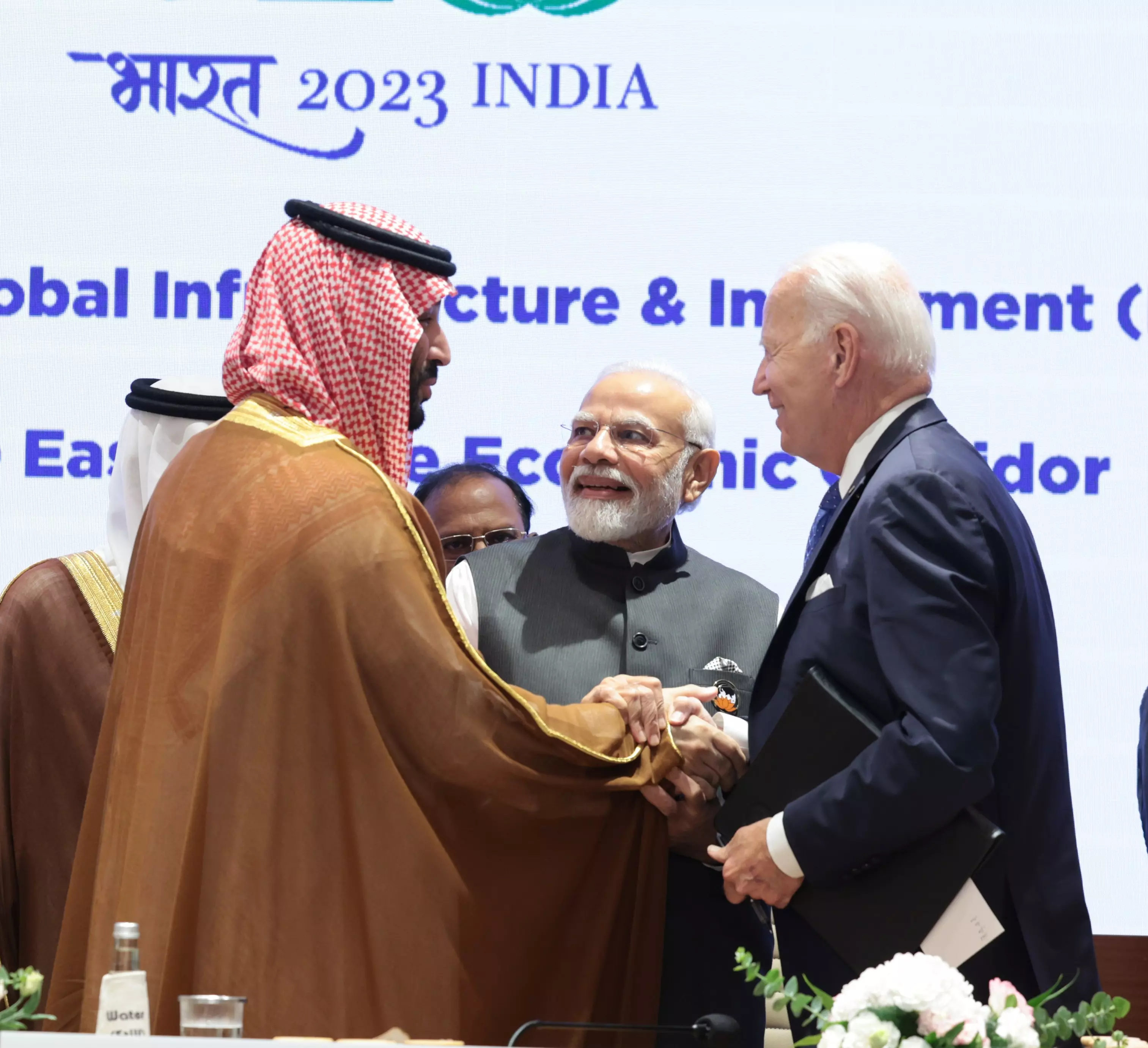
Middle East-Europe Corridor can be plug-and-play for India
IMEC deal, announced at G20 summit, presents various opportunities for the countries involved

The India-Middle East-Europe Economic Corridor (IMEC) will connect three regions but much of the action and investment is set to unfold in the Middle East. The United Arab Emirates (UAE), Jordan, Saudi Arabia and Israel will be the countries that will have to invest in railway lines and other logistics facilities to divert traffic between Europe and India from the Suez Canal.
According to the MoU that the United States, the UAE, the European Union, India, Italy, France, Germany and Saudi Arabia signed during the G20 summit in Delhi, ships will transport goods between the west coast of India and a transshipment port in the UAE, from where they will travel by rail through Saudi Arabia and Jordan to Israel. The distance between the Israeli port of Haifa and the Greek port of Piraeus will be covered by ship, according to commentary in Israeli newspapers.
A Jewish researcher of Indian origin in Jerusalem said it would cut transit time between Mumbai and Europe by 40 per cent. Hyped up gains are usually claimed when such grand projects are initiated. The Middle East railway leg will have to be quite competitive to make transshipment worthwhile.
The shipping lines between India and Europe are well-established. As if it was anticipated, the Adani Group (and Israel’s Gadot Group) are now the new owners of Haifa port, after winning a privatisation bid in March. The investment in railways will have to be done by the participant countries in the Middle East. They are positioned to do so.
Pakistan can also plug into this corridor, as it certainly will, but it would help if the corridor spurred Pakistan and India to allow overland trade to and through their countries
Saudi Arabia has ambitious plans to develop its economy. By 2030, it wants to be a technology, logistics, trade and tourism hub and reduce dependence on oil. The country is building a railway network after neglecting it since 1951, when the first railway line was established. It has 2,100 km of freight track. Saudi Arabia Railways says on its website that it intends to extend the railway link from the Red Sea port of Jeddah to borders with Israel, Yemen and perhaps Egypt.
UAE aspires to be another Singapore
UAE also wants to be like Singapore in trade, industry and tourism. In May 2022, it signed a free trade agreement with India with the objective of increasing trade to $100 billion in five years. Last year, two-way trade with the country was worth $85 billion, up from $59 billion just before the pandemic in 2019-20. It also wants Indian industry to make it a base for exports.
From 279 km of freight track in 2021, it now has 1,200 km connecting all the seven emirates and Saudi Arabia. Etihad Railways says it will have a cargo capacity of 60 million tonnes by 2030.
The other members of the Gulf Cooperation Council – Bahrain, Kuwait and Qatar – are also expected to join in with road and rail linkages.
Challenges for Saudi
A lot will hinge on how soon Saudi Arabia and Israel will settle their differences and establish diplomatic relations, which have been cut off for 75 years since Israel was established.
Israeli Prime Minister Benjamin Netanyahu has hailed the project as good for the country and transformative for the region. But his hard-right coalition partners in the government are Jewish supremacists, intolerant of Palestinian autonomy. Saudi Arabia cannot normalise relations without obtaining concessions from Israel that assure Palestinians of dignity and development. Apart from security guarantees, it wants US consent to enrich uranium for nuclear energy – which carries the risk of nuclear weapons proliferation.
Pakistan and India factor
Pakistan can also into this corridor, as it certainly will, but it would help if the corridor spurred Pakistan and India to allow overland trade to and through their countries as Prime Minister Atal Behari Vajpayee had articulated in 2003 (open borders and a common South Asian market). This will boost the economies of India’s northern states. Pakistan and India will get their goods cheaper than importing them through the UAE. Pakistan’s trade with that country was worth $10.03 billion in financial year 2022.
As between Saudi Arabia and Israel, politics comes in the way. Pakistan’s military establishment may not want normalisation, nor is India’s ruling ideology conducive.
After the Pulwama attack in 2019, India imposed punitive 200 per cent tariffs on Pakistani imports. Pakistan halted trade through the Wagah border after India set aside Article 370 and abolished Jammu & Kashmir’s statehood.
India’s trade with Pakistan has declined from $0.8 million (0.11 percent of its total trade) in 2019-20 to $0.6 million (0.06 percent) last year. (Pakistan is doing all the buying. India bought Pakistani goods worth just $20,110 in 2022-23). In fact, Pakistan’s exports more to Bangladesh ($947 million in financial year 2022) than its trades with India.
With overland routes opened up India will get quicker access to Iran and Central Asia and Pakistan to Bangladesh and East Asia.

